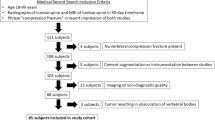Summary
It would be valuable to use cadaveric models of cervical vertebrae and spinal cord to assess how varying degrees of traumatic subluxation would relate to neurological damage. However, before such a study may be undertaken, it would be important to assess the degree of shrinkage or expansion of the spinal cord that occurs during the embalming process. This is achieved in this study by comparing diameters of cadaveric spinal cord to that of sagittal magnetic resonance scans of living subjects. The geometric measurements of radiographs in living subjects has been assessed but no direct model for spinal cord injury has been described [1].
If embalmed spinal cord diameters were a good estimator of living spinal cord diameters then cadaveric cervical spines could be used as a model. By reproducing various degrees of fracture and dislocation the extent of corresponding cord compression could be assessed. Our study shows that spinal cord dimensions increase after embalming using the Cambridge procedure [4].
Résumé
Il y aurait un grand intérêt à utiliser des vertèbres cervicales et des moelles épinières issues de cadavres pour évaluer quels degrés de subluxation traumatique et quelles lésions nerveuses sont liés. Cependant, avant d'entreprendre une telle étude, il serait important d'appréhender le degré de rétrécissement ou d'élargissement de la moelle épinière qui survient au cours de l'embaumement. C'est ce que nous avons réalisé dans ce travail en comparant les diamètres de la moelle épinière de cadavres à ceux de coupes sagittales obtenues par résonance magnétique nucléaire sur des sujets vivants. Les mesures géométriques sur des radiographies de sujets vivants ont déjà été évaluées, mais aucun modèle directement applicable aux traumatismes de la moelle épinière n'a été décrit [1]. Si les diamètres des moelles épinières embaumées représentaient fidèlement les diamètres des moelles épinières des sujets vivants, les colonnes cervicales de cadavres pourraient être utilisées comme modèles. On pourrait évaluer l'importance de la compression de la moelle épinière correspondant à des degrés variés de fractures et de luxations. Notre étude montre que les dimensions de moelles épinières augmentent après l'embaumement selon la technique de Cambridge [4].
Similar content being viewed by others
References
Gilad I, Nissan M (1985) Sagittal evaluation of elemental geometrical dimensions of human vertebrae. J Anat 143: 115–120
Kohn MI, Tanna NK, Herman GT, Resmick SM, Mozley PD, Gur RE, Alavi A, Zimmerman RA, Gur RC (1991) Analysis of brain and cerebrospinal fluid volumes with MR imaging. Radiology 178: 115–122
Levine AM, Edwards CC (1986) Treatment of injuries in the C1–C2 complex. Orthop Clin North Am 17: 31–43
Logan BM (1983) The long-term preservation of whole human cadavers destined for anatomical study. Ann R Coll Surg Engl 65: 333
Reicher MA, Gold RH, Halbach VV, Rauschning W, Wilson GH, Lufkin RB (1986) MR imaging of the lumbar spine: anatomic correlations and the effects of technical variations. AJR 147: 891–898
Riggins RS, Kraus JF (1977) The risk of neurologic damage with fractures of the vertebrae. J Trauma 17: 126–133
Roaf RR (1960) A study of the mechanisms of spinal injuries. J Bone Joint Surg [Br] 42-B: 810–823
Author information
Authors and Affiliations
Rights and permissions
About this article
Cite this article
Choi, D., Carroll, N. & Abrahams, P. Spinal cord diameters in cadaveric specimens and magnetic resonance scans, to assess embalming artefacts. Surg Radiol Anat 18, 133–135 (1996). https://doi.org/10.1007/BF01795233
Received:
Accepted:
Issue Date:
DOI: https://doi.org/10.1007/BF01795233




